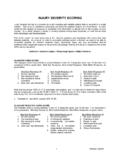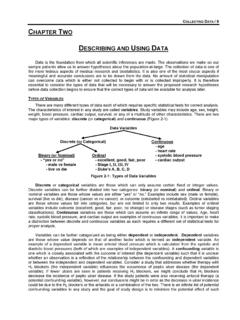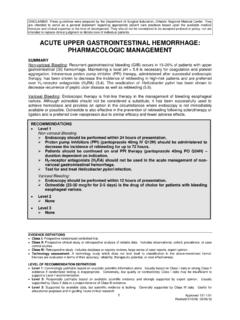Transcription of PRESUMPTIVE ANTIBIOTICS FOR CHEST TUBE …
1 DISCLAIMER: These guidelines were prepared by the Department of Surgical Education, Orlando Regional Medical Center. They are intended to serve as a general statement regarding appropriate patient care practices based upon the available medical literature and clinical expertise at the time of development. They should not be considered to be accepted protocol or policy, nor are intended to replace clinical judgment or dictate care of individual patients. EVIDENCE DEFINITIONS Class I: Prospective randomized controlled trial. Class II: Prospective clinical study or retrospective analysis of reliable data. Includes observational, cohort, prevalence, or case control studies. Class III: Retrospective study. Includes database or registry reviews, large series of case reports, expert opinion.
2 Technology assessment: A technology study which does not lend itself to classification in the above-mentioned format. Devices are evaluated in terms of their accuracy, reliability, therapeutic potential, or cost effectiveness. LEVEL OF RECOMMENDATION DEFINITIONS Level 1: Convincingly justifiable based on available scientific information alone. Usually based on Class I data or strong Class II evidence if randomized testing is inappropriate. Conversely, low quality or contradictory Class I data may be insufficient to support a Level I recommendation. Level 2: Reasonably justifiable based on available scientific evidence and strongly supported by expert opinion. Usually supported by Class II data or a preponderance of Class III evidence.
3 Level 3: Supported by available data, but scientific evidence is lacking. Generally supported by Class III data. Useful for educational purposes and in guiding future clinical research. 1 Approved 5/16/2005 Revised 10/20/ 2009 , 03/06/2013 PRESUMPTIVE ANTIBIOTICS FOR CHEST TUBE INSERTION SUMMARY There has been much debate regarding the role for prophylactic ANTIBIOTICS following CHEST tube placement, particularly those placed in the setting of trauma. Attempts to study this question through randomized controlled trials have been plagued by insufficient power. There is currently insufficient evidence to support the routine use of prophylactic ANTIBIOTICS following CHEST tube insertion.
4 Consideration of additional risk factors for infection, such as mechanism of injury, hemothorax, retained hydrothorax, alcoholism, or presence of chronic disease, may provide guidance in determining which patients should receive PRESUMPTIVE antimicrobial therapy. When administered, ANTIBIOTICS should have activity against the most likely causative pathogens (typically gram-positive bacteria). INTRODUCTION Although the use of peri-operative prophylactic antibiotic therapy is well established, the use of prophylactic ANTIBIOTICS for CHEST tube placement remains controversial. The reported incidence of infectious complications following CHEST tube insertion for thoracic injuries ranges from 2 to 35 percent.
5 The body of literature addressing this issue has yielded mixed results due to a number of factors such as differences in study design, sample size, choice of antimicrobial agent, duration of therapy, and RECOMMENDATIONS Level 1 None Level 2 There is insufficient data to support the routine use of PRESUMPTIVE ANTIBIOTICS for the prevention of infectious complications in patients who undergo tube thoracostomy for spontaneous pneumothorax. Level 3 PRESUMPTIVE ANTIBIOTICS should be considered for the prevention of infectious complications in patients who: Undergo CHEST tube placement for traumatic pneumothorax / hemothorax AND have additional risk factors for infection Hemothorax Retained hydrothorax Contaminated hemothorax When administered, cefazolin 1-2 gm every 8 hours should be given for 24 hours.
6 The first dose should ideally be administered prior to insertion or within 1 hour of insertion in emergent situations. For patients with penicillin hypersensitivity, vancomycin or clindamycin are alternatives. 2 Approved 5/16/2005 Revised 10/20/ 2009 differences in patient population such as spontaneous pneumothorax, blunt trauma, penetrating trauma, and associated hollow viscus injury. The definition of an infectious complication has also varied between studies. As a result, there are currently no clear cut recommendations regarding antibiotic use in patients requiring thoracostomy to treat CHEST injury. Given the variable outcomes in the available literature, the potential benefit of PRESUMPTIVE ANTIBIOTICS must be assessed in conjunction with the risks associated with this therapy.
7 LITERATURE REVIEW Seventy-five patients with isolated penetrating CHEST wounds were randomized prospectively in a double-blind study to determine the efficacy of ANTIBIOTICS in patients undergoing tube thoracostomy (1). Thirty eight patients were randomized to Group A and received 300 milligrams of clindamycin intravenously every 6 hours, beginning at admission and continuing until one day following CHEST tube removal, or for 5 days, whichever period was shorter. Thirty seven patients were randomized to receive placebo (Group B) on the same schedule. Evidence of pneumonia on CHEST X-ray was found in of patients in Group A versus 35% in Group B (p < ). Favorable trends were noted in length of stay, temperature elevation, white blood cell counts, incidence of empyema, wound infection, positive pleural and wound cultures, and surgical interventions in Group A, but none reached statistical significance.
8 Empyema developed in of patients in Group B, as compared to in Group A (p= ). The trial was terminated early due to reports of diarrhea and pseudomembranous colitis after clindamycin therapy. The authors concluded that many of the parameters measured may have reached statistical significance with a larger study population. (Class I) Stone and colleagues conducted a randomized, double-blind trial involving 120 patients with isolated thoracic trauma to evaluate the efficacy of antibiotic therapy in the prevention of post-traumatic pulmonary and pleural related infections (2). Patients were randomized to placebo (n = 60) or cefamandole (n = 60) 1 gram IV/IM every 6 hours at the time of tube insertion and continued until the second day following tube removal.
9 Infection was defined as gross purulent discharge from the pleural space or the development of purulent sputum with X-ray confirmation of the presence of an active pneumonia or an intrapulmonary abscess. A positive culture, fever, and leukocytosis were also required for the diagnosis of infection. Penetrating trauma resulting in hemothorax, pneumothorax or both was the indication for thoracostomy tube insertion in 46 patients. Thirty five patients experienced spontaneous pneumothorax. The remaining two patients developed a non-traumatic pneumothorax. There was no difference in average duration of tube placement, treatment with antibiotic or placebo, or length of hospital stay. There was a significant difference in infection rate between the placebo and cefamandole groups ( versus ; p< ).
10 Infections consisted of empyema, lung abscess, and pneumonia. There was no difference, however, in infection rates in the subset of patients with spontaneous pneumothorax receiving either antibiotic therapy or placebo. No major adverse events were reported. (Class I) Cant and colleagues conducted a randomized, double-blind, placebo controlled study in patients with stab wounds of the CHEST requiring drainage of the pleural space to determine whether short term ANTIBIOTICS decreased the rate of infectious complications (3). The endpoints of the study were thoracotomy, significant pyrexia (Temp > 38 C 2 times during admission), positive cultures (from drain fluid or tip, or sputum) or an elevated WBC count (> 11,000).










